display BMW X5 2005 E53 Central Body Electronics Workshop Manual
[x] Cancel search | Manufacturer: BMW, Model Year: 2005, Model line: X5, Model: BMW X5 2005 E53Pages: 64, PDF Size: 4.03 MB
Page 28 of 64
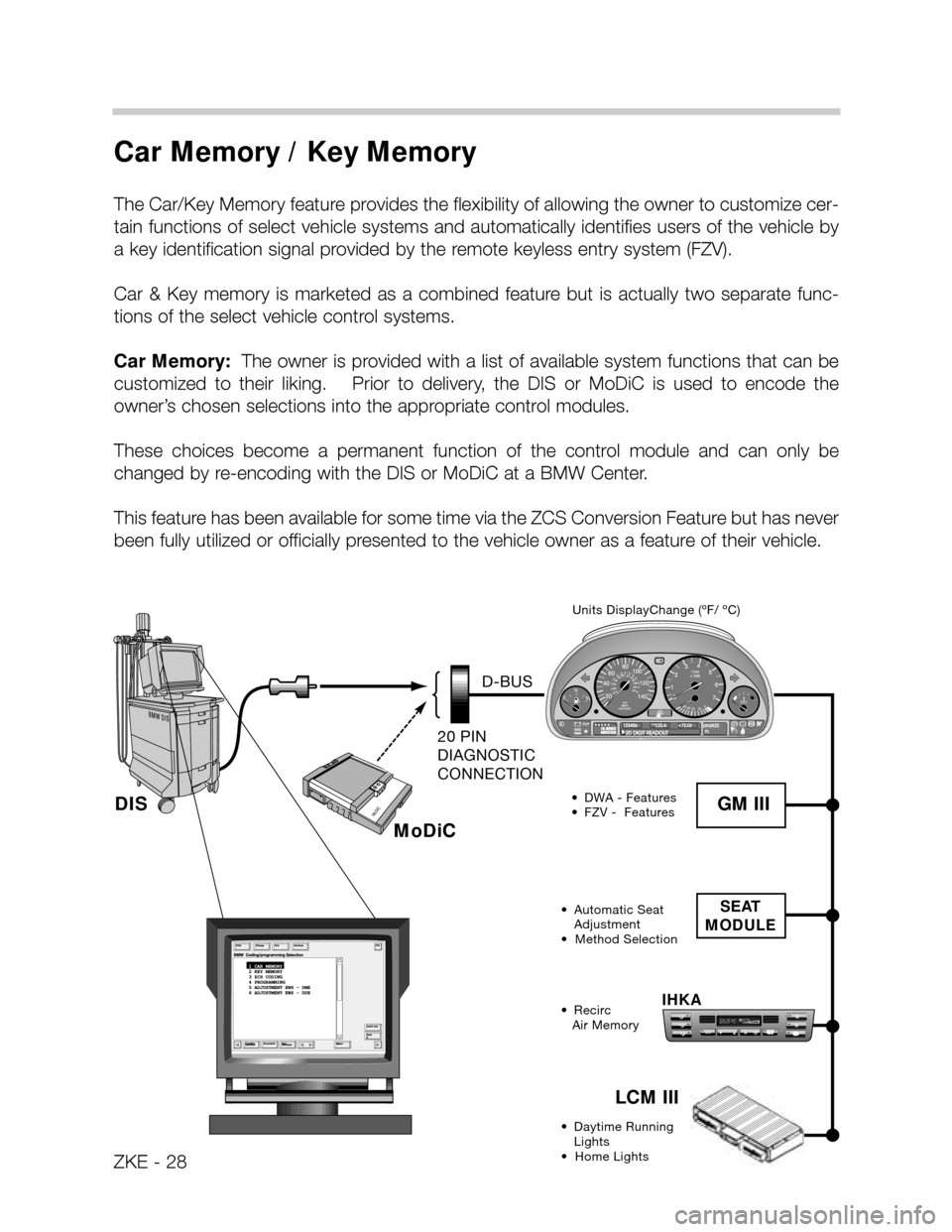
Car Memory / Key Memory
The Car/Key Memory feature provides the flexibility of allowing the owner to customize cer-
tain functions of select vehicle systems and automatically identifies users of the vehicle by
a key identification signal provided by the remote keyless entry system (FZV).
Car & Key memory is marketed as a combined feature but is actually two separate func-
tions of the select vehicle control systems.
Car Memory: The owner is provided with a list of available system functions that can be
customized to their liking. Prior to delivery, the DIS or MoDiC is used to encode the
owner’s chosen selections into the appropriate control modules.
These choices become a permanent function of the control module and can only be
changed by re-encoding with the DIS or MoDiC at a BMW Center.
This feature has been available for some time via the ZCS Conversion Feature but has never
been fully utilized or officially presented to the vehicle owner as a feature of their vehicle.
Units DisplayChange (ºF/ ºC)
• DWA - Features
• FZV - Features
• Automatic Seat
Adjustment
• Method Selection
• Recirc
Air Memory
• Daytime Running
Lights
• Home Lights
UNLEADED GASOLINE ONLY01
220km/hMPH1/min
x1000
40 6080100120
140
160
180
200
220
240
1
023
4
5
6
75030
20
15
1220 406080
100
120
1401
1
MoDiC
20 PIN
DIAGNOSTIC
CONNECTION
MoDiC
D-BUS
DIS
A
SEAT
MODULE
GMV
IHKA
LSZ
ZKE - 28
LCM III
GM III
Page 30 of 64
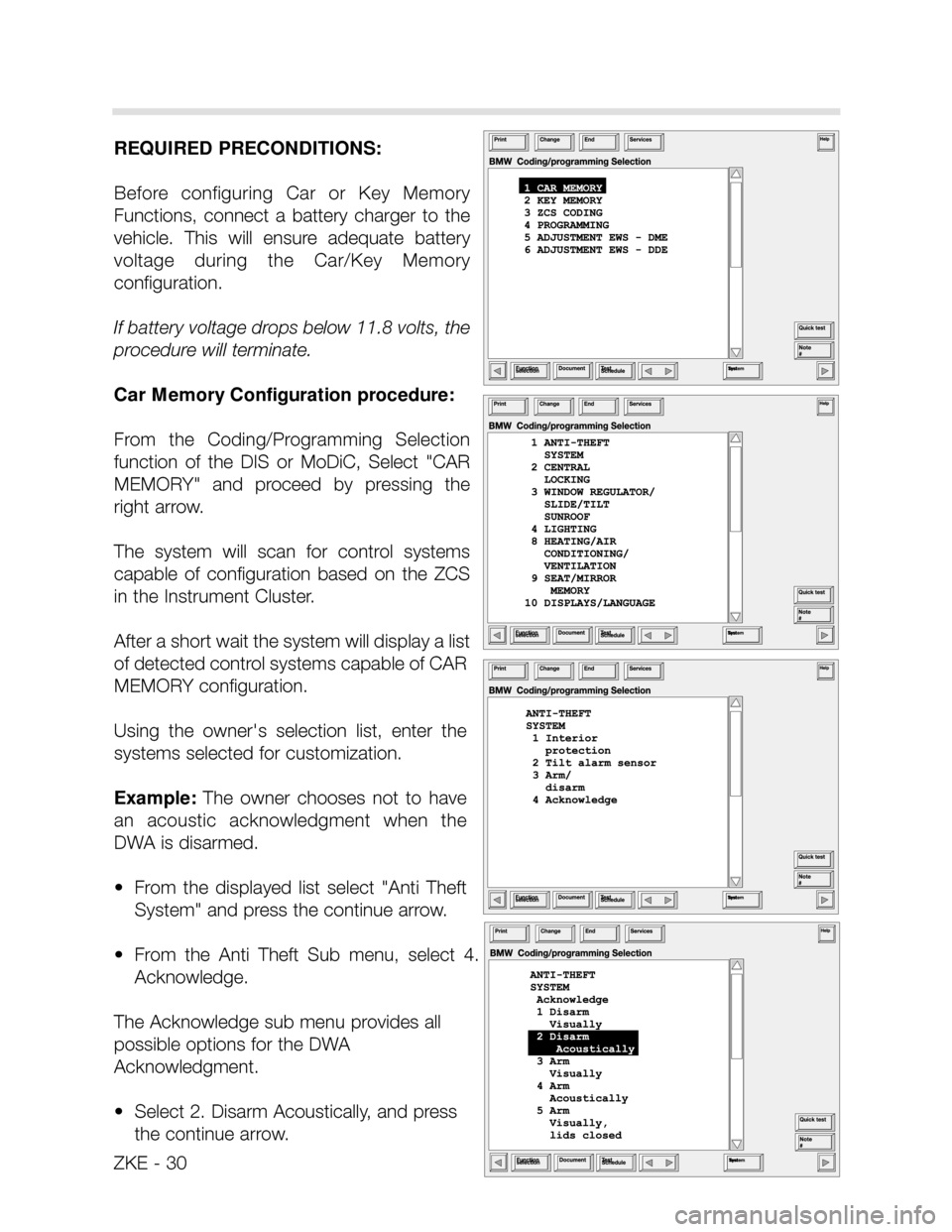
ZKE - 30
REQUIRED PRECONDITIONS:
Before configuring Car or Key Memory
Functions, connect a battery charger to the
vehicle. This will ensure adequate battery
voltage during the Car/Key Memory
configuration.
If battery voltage drops below 11.8 volts, the
procedure will terminate.
Car Memory Configuration procedure:
From the Coding/Programming Selection
function of the DIS or MoDiC, Select "CAR
MEMORY" and proceed by pressing the
right arrow.
The system will scan for control systems
capable of configuration based on the ZCS
in the Instrument Cluster.
After a short wait the system will display a list
of detected control systems capable of CAR
MEMORY configuration.
Using the owner's selection list, enter the
systems selected for customization.
Example:The owner chooses not to have
an acoustic acknowledgment when the
DWA is disarmed.
• From the displayed list select "Anti Theft
System" and press the continue arrow.
• From the Anti Theft Sub menu, select 4.
Acknowledge.
The Acknowledge sub menu provides all
possible options for the DWA
Acknowledgment.
• Select 2. Disarm Acoustically, and press
the continue arrow.
Page 31 of 64
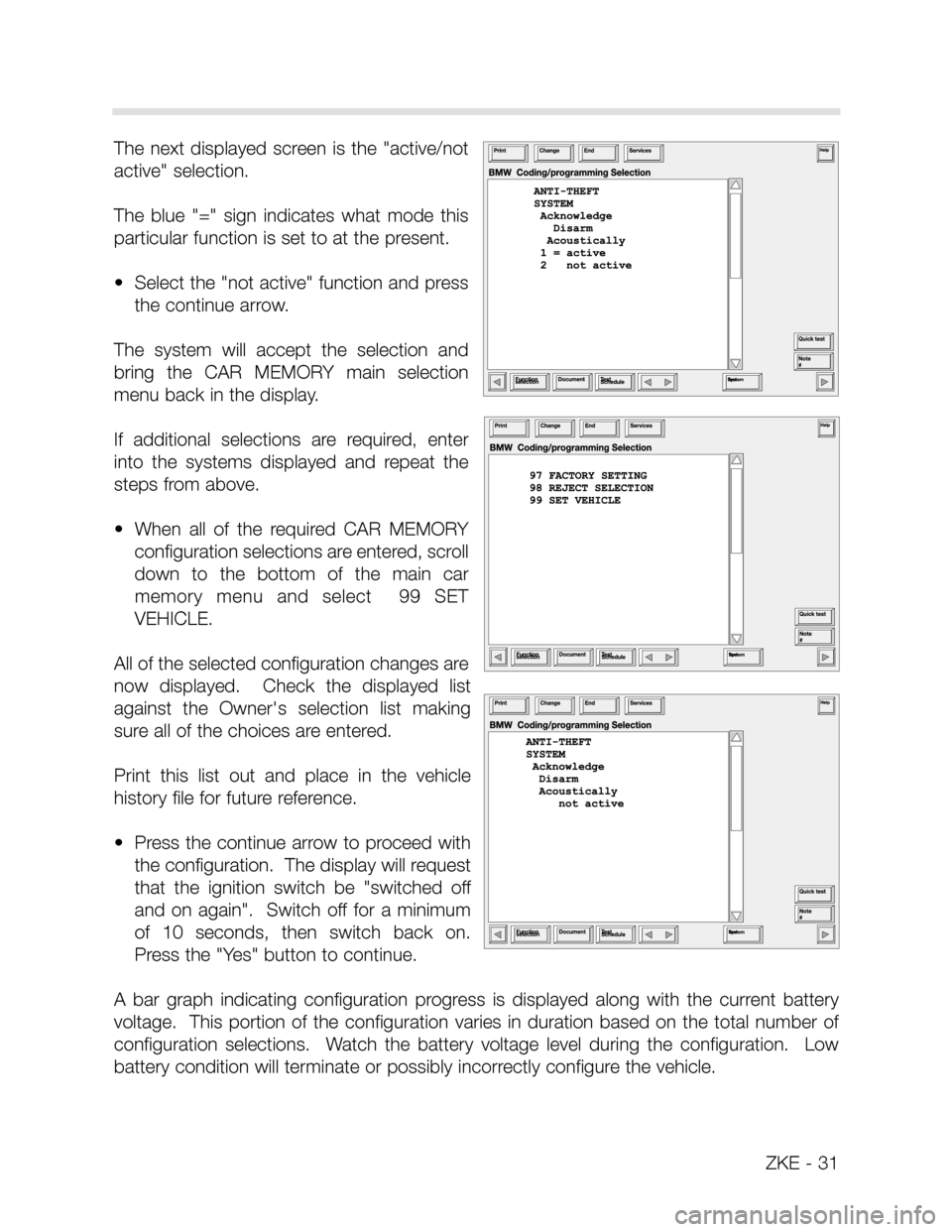
ZKE - 31
The next displayed screen is the "active/not
active" selection.
The blue "=" sign indicates what mode this
particular function is set to at the present.
• Select the "not active" function and press
the continue arrow.
The system will accept the selection and
bring the CAR MEMORY main selection
menu back in the display.
If additional selections are required, enter
into the systems displayed and repeat the
steps from above.
• When all of the required CAR MEMORY
configuration selections are entered, scroll
down to the bottom of the main car
memory menu and select 99 SET
VEHICLE.
All of the selected configuration changes are
now displayed. Check the displayed list
against the Owner's selection list making
sure all of the choices are entered.
Print this list out and place in the vehicle
history file for future reference.
• Press the continue arrow to proceed with
the configuration. The display will request
that the ignition switch be "switched off
and on again". Switch off for a minimum
of 10 seconds, then switch back on.
Press the "Yes" button to continue.
A bar graph indicating configuration progress is displayed along with the current battery
voltage. This portion of the configuration varies in duration based on the total number of
configuration selections. Watch the battery voltage level during the configuration. Low
battery condition will terminate or possibly incorrectly configure the vehicle.
Page 32 of 64
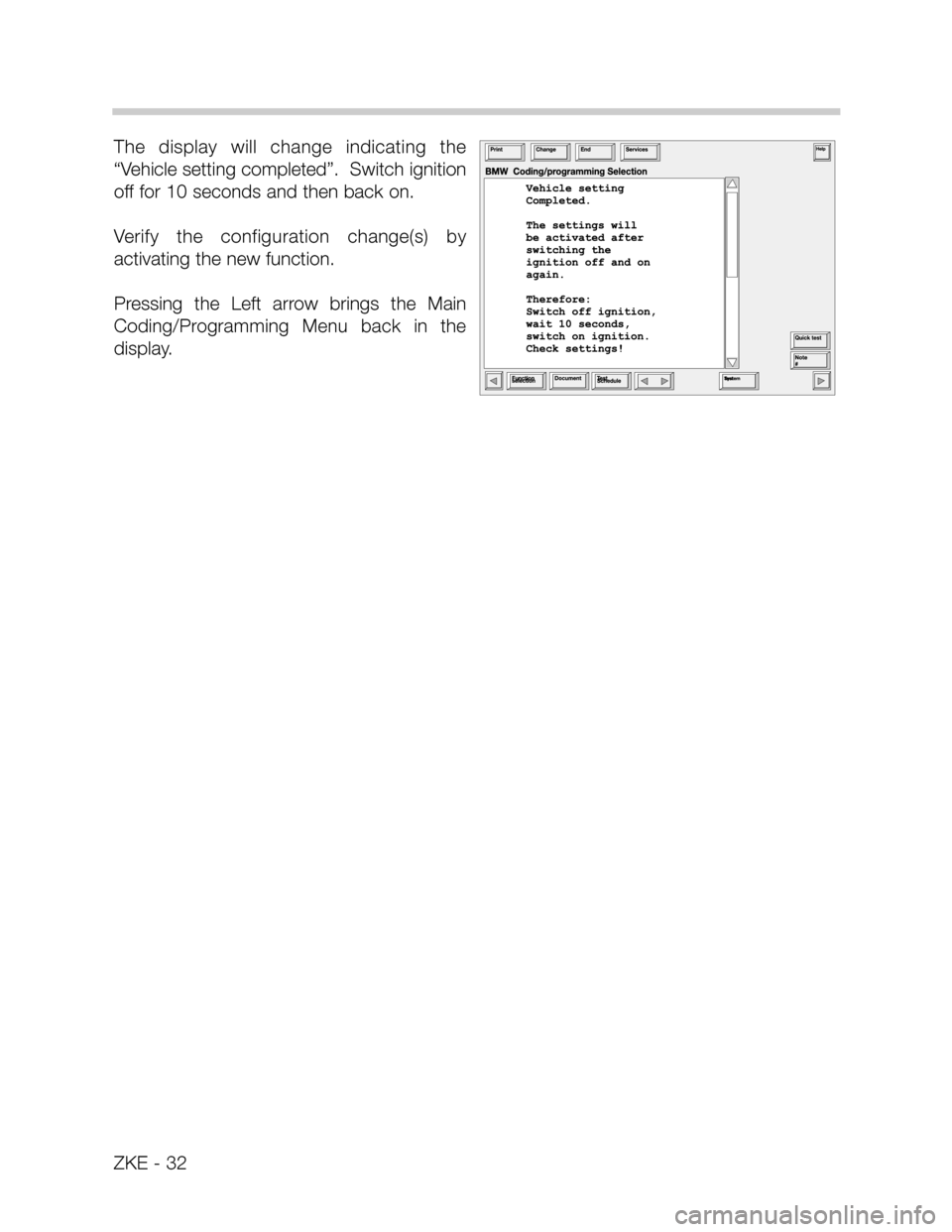
The display will change indicating the
“Vehicle setting completed”. Switch ignition
off for 10 seconds and then back on.
Verify the configuration change(s) by
activating the new function.
Pressing the Left arrow brings the Main
Coding/Programming Menu back in the
display.
ZKE - 32
Page 33 of 64
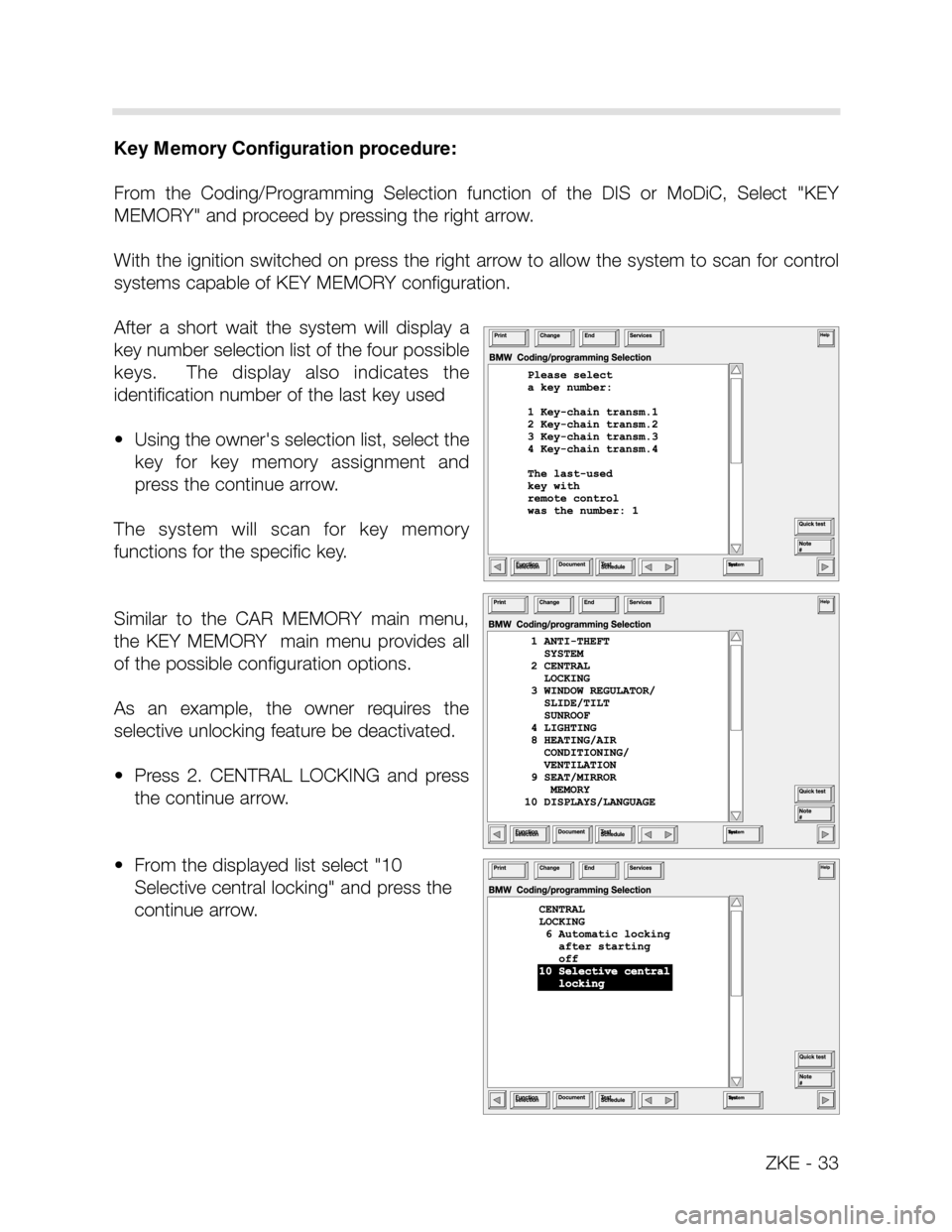
ZKE - 33
Key Memory Configuration procedure:
From the Coding/Programming Selection function of the DIS or MoDiC, Select "KEY
MEMORY" and proceed by pressing the right arrow.
With the ignition switched on press the right arrow to allow the system to scan for control
systems capable of KEY MEMORY configuration.
After a short wait the system will display a
key number selection list of the four possible
keys. The display also indicates the
identification number of the last key used
• Using the owner's selection list, select the
key for key memory assignment and
press the continue arrow.
The system will scan for key memory
functions for the specific key.
Similar to the CAR MEMORY main menu,
the KEY MEMORY main menu provides all
of the possible configuration options.
As an example, the owner requires the
selective unlocking feature be deactivated.
• Press 2. CENTRAL LOCKING and press
the continue arrow.
• From the displayed list select "10
Selective central locking" and press the
continue arrow.
Page 34 of 64
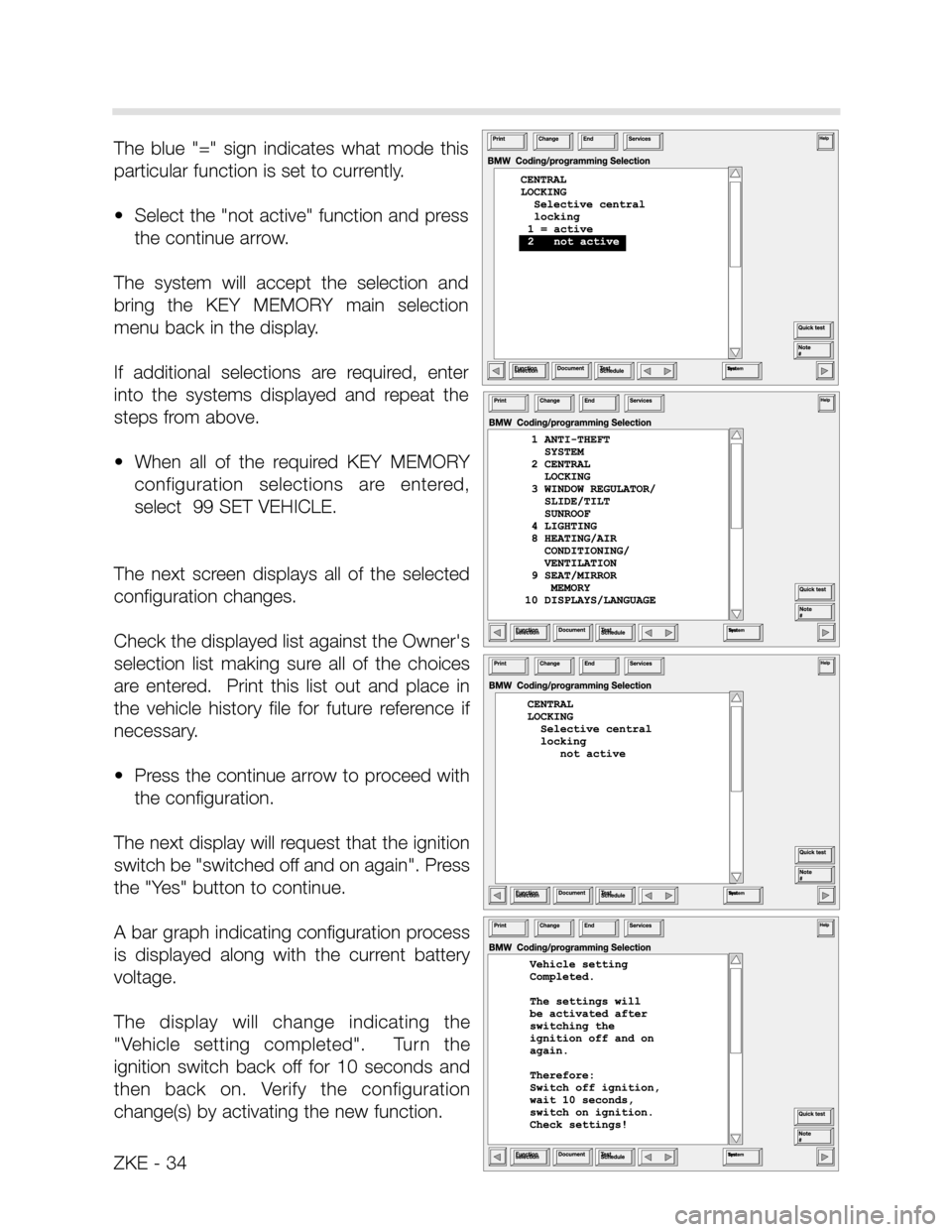
ZKE - 34
The blue "=" sign indicates what mode this
particular function is set to currently.
• Select the "not active" function and press
the continue arrow.
The system will accept the selection and
bring the KEY MEMORY main selection
menu back in the display.
If additional selections are required, enter
into the systems displayed and repeat the
steps from above.
• When all of the required KEY MEMORY
configuration selections are entered,
select 99 SET VEHICLE.
The next screen displays all of the selected
configuration changes.
Check the displayed list against the Owner's
selection list making sure all of the choices
are entered. Print this list out and place in
the vehicle history file for future reference if
necessary.
• Press the continue arrow to proceed with
the configuration.
The next display will request that the ignition
switch be "switched off and on again". Press
the "Yes" button to continue.
A bar graph indicating configuration process
is displayed along with the current battery
voltage.
The display will change indicating the
"Vehicle setting completed". Turn the
ignition switch back off for 10 seconds and
then back on. Verify the configuration
change(s) by activating the new function.
Page 36 of 64
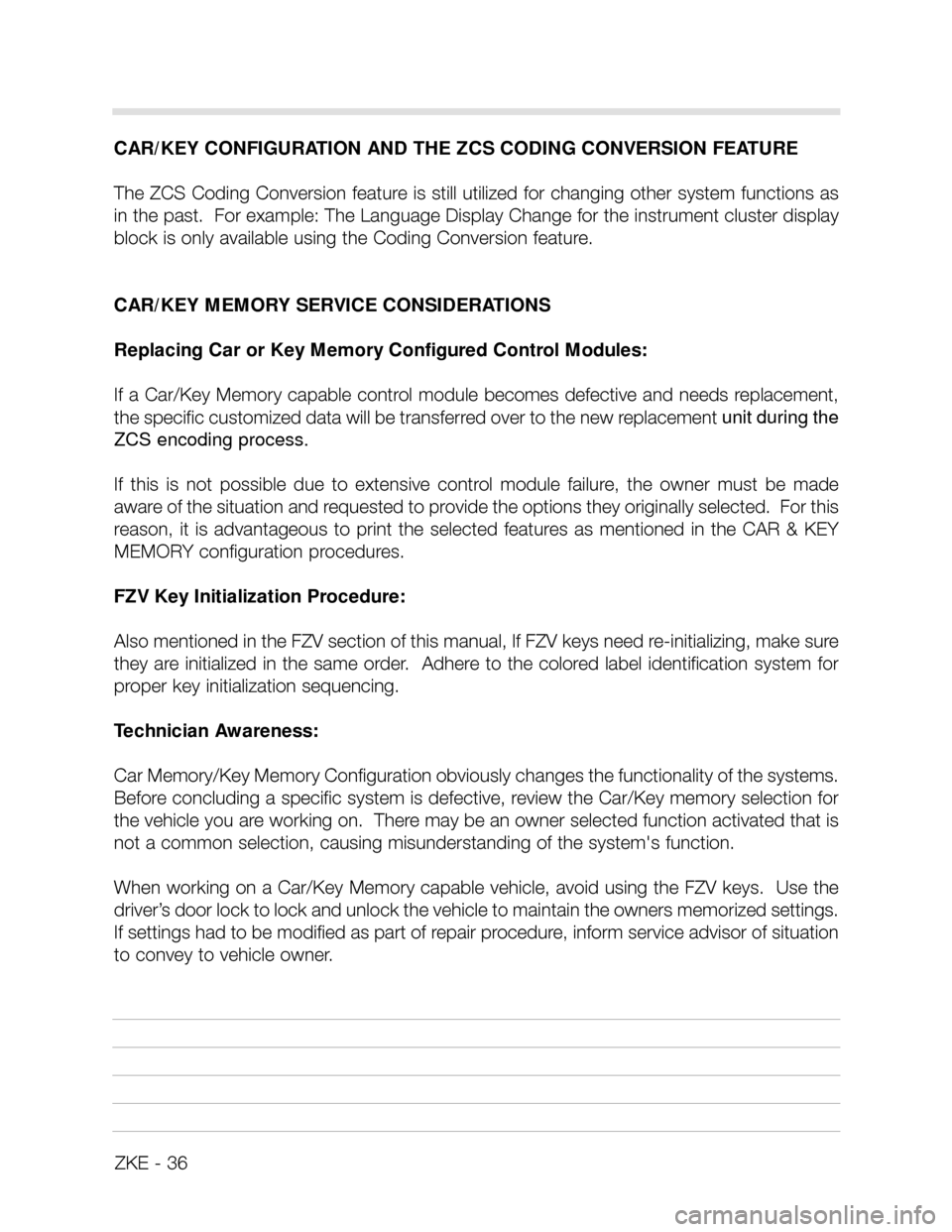
ZKE - 36
CAR/KEY CONFIGURATION AND THE ZCS CODING CONVERSION FEATURE
The ZCS Coding Conversion feature is still utilized for changing other system functions as
in the past. For example: The Language Display Change for the instrument cluster display
block is only available using the Coding Conversion feature.
CAR/KEY MEMORY SERVICE CONSIDERATIONS
Replacing Car or Key Memory Configured Control Modules:
If a Car/Key Memory capable control module becomes defective and needs replacement,
the specific customized data will be transferred over to the new replacement unit during the
ZCS encoding process.
If this is not possible due to extensive control module failure, the owner must be made
aware of the situation and requested to provide the options they originally selected. For this
reason, it is advantageous to print the selected features as mentioned in the CAR & KEY
MEMORY configuration procedures.
FZV Key Initialization Procedure:
Also mentioned in the FZV section of this manual, If FZV keys need re-initializing, make sure
they are initialized in the same order. Adhere to the colored label identification system for
proper key initialization sequencing.
Technician Awareness:
Car Memory/Key Memory Configuration obviously changes the functionality of the systems.
Before concluding a specific system is defective, review the Car/Key memory selection for
the vehicle you are working on. There may be an owner selected function activated that is
not a common selection, causing misunderstanding of the system's function.
When working on a Car/Key Memory capable vehicle, avoid using the FZV keys. Use the
driver’s door lock to lock and unlock the vehicle to maintain the owners memorized settings.
If settings had to be modified as part of repair procedure, inform service advisor of situation
to convey to vehicle owner.
Page 54 of 64
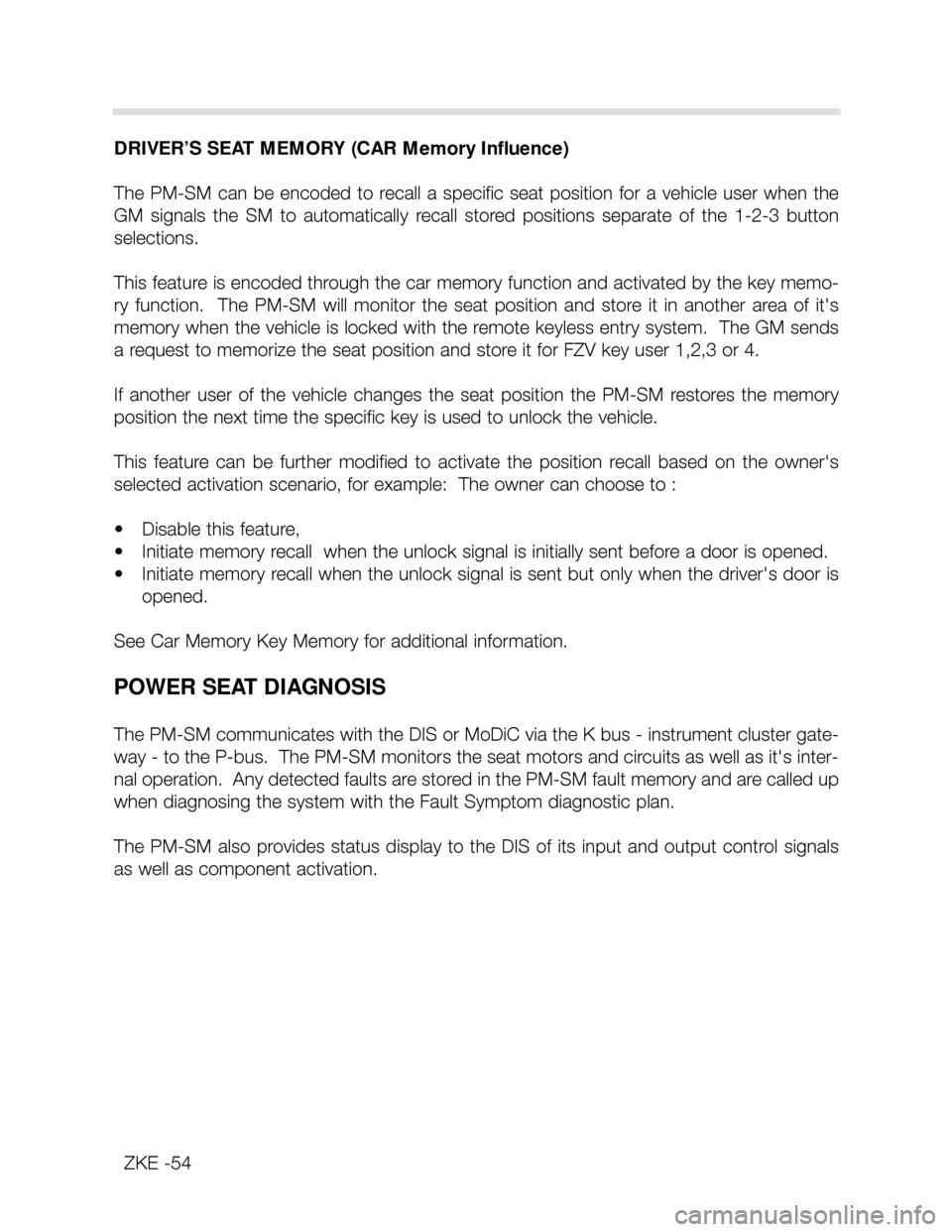
ZKE -54
DRIVER’S SEAT MEMORY (CAR Memory Influence)
The PM-SM can be encoded to recall a specific seat position for a vehicle user when the
GM signals the SM to automatically recall stored positions separate of the 1-2-3 button
selections.
This feature is encoded through the car memory function and activated by the key memo-
ry function. The PM-SM will monitor the seat position and store it in another area of it's
memory when the vehicle is locked with the remote keyless entry system. The GM sends
a request to memorize the seat position and store it for FZV key user 1,2,3 or 4.
If another user of the vehicle changes the seat position the PM-SM restores the memory
position the next time the specific key is used to unlock the vehicle.
This feature can be further modified to activate the position recall based on the owner's
selected activation scenario, for example: The owner can choose to :
• Disable this feature,
• Initiate memory recall when the unlock signal is initially sent before a door is opened.
• Initiate memory recall when the unlock signal is sent but only when the driver's door is
opened.
See Car Memory Key Memory for additional information.
POWER SEAT DIAGNOSIS
The PM-SM communicates with the DIS or MoDiC via the K bus - instrument cluster gate-
way - to the P-bus. The PM-SM monitors the seat motors and circuits as well as it's inter-
nal operation. Any detected faults are stored in the PM-SM fault memory and are called up
when diagnosing the system with the Fault Symptom diagnostic plan.
The PM-SM also provides status display to the DIS of its input and output control signals
as well as component activation.